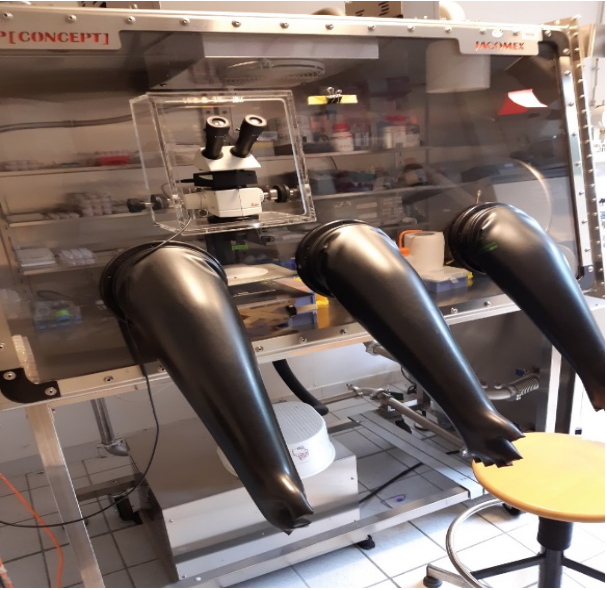P. Carpentier
The team BioCat is in charge of a platform of crystallogenesis and crystallography dedicated to metallo-proteins. This support activity is a common service that benefits all teams of the LCBM laboratory and external collaborators. The crystallogenesis service allow the screening, analyzing and optimizing of crystallization conditions on the basis of the main commercial crystallization kits. Crystallization screening can be handled either in an incubator under aerobic condition (under controlled temperature) for all usual proteins, or in a glovebox under anaerobic conditions (under controlled atmosphere and temperature) for protein that are specifically sensitive to O
2. Crystals selected for diffraction experiments are stored over long periods in a Dewar under cryogenic conditions.

Glove-box dedicated for crystallization of metallo-enzymes under anaerobic conditions.
A collaboration with structural biology group of the European synchrotron (ESRF) allows us recording directly X-ray diffraction data and solving the structures of the metallo-enzymes. Furthermore, in order to dissect in further details the catalytic mechanism on the basis of the X-ray structures, we are developing original methods to complement X-ray crystallography data. Functional states of metallo-enzymes (redox for instance), related to different reaction intermediates observed “
in cristallo” can be characterized using optical spectroscopy data (Raman and/or UV/visible absorption) that are recorded directly in the same crystals used for X-ray (laboratory icOS).
We are also developing labelling techniques for biological crystals using noble gases (He, Ar, Kr and Xe) under pressure that allow mapping the functional internal channels of enzymes (laboratory HPMX ESRF). Deciphering the architecture of these functional channels allows understandings substrates transport and products export processes that take place between the solvent and the active site, which is essential for the comprehending the mechanism of enzymes with buried catalytic centers.
 Link to external web sites of interest
icOS lab
HPMX lab
Link to external web sites of interest
icOS lab
HPMX lab
 Recent literature examples
Recent literature examples Ligand pathways in neuroglobin revealed by low-temperature photodissociation and docking experiments.
C Ardiccioni,
et al., IUCrJ 6 (5) (2019)
Tracking the route of molecular oxygen in O
2-tolerant membrane-bound [NiFe] hydrogenase.
J. Kalms
et al. , Proceedings of the National Academy of Sciences 115 (10), E2229-E2237 (2018)